en
names in breadcrumbs


Cosmos sulphureus is a species of flowering plant in the sunflower family Asteraceae, also known as sulfur cosmos and yellow cosmos. It is native to Mexico, Central America, and northern South America, and naturalized in other parts of North and South America as well as in Europe, Asia, and Australia.[2][3][4][5][6][7][8]
This plant was declared invasive by the United States Southeast Exotic Pest Plant Council in 1996.[9] The flowers of all Cosmos attract birds and butterflies, including the monarch butterfly.
This species of Cosmos is considered a half-hardy annual, although plants may re-appear via self-sowing for several years. Its foliage is opposite and pinnately divided. The plant height varies from 1–7 feet (30–210 cm). The original and its cultivars appear in shades of yellow, orange, and red. It is especially popular in Korea and Japan, where it is often seen in mass plantings along roadsides, following an initiative pursued by the Korean-Japanese botanist Woo Jang-choon.
Cultivars include:
(those marked agm have gained the Royal Horticultural Society's Award of Garden Merit).
Growth characteristics of this plant include:[12]
 a Cosmos sp. at Yogyakarta region of Indonesia
a Cosmos sp. at Yogyakarta region of Indonesia Cosmos sulphureus is a species of flowering plant in the sunflower family Asteraceae, also known as sulfur cosmos and yellow cosmos. It is native to Mexico, Central America, and northern South America, and naturalized in other parts of North and South America as well as in Europe, Asia, and Australia.
This plant was declared invasive by the United States Southeast Exotic Pest Plant Council in 1996. The flowers of all Cosmos attract birds and butterflies, including the monarch butterfly.
Cosmos sulphureus, cosmos, cosmos azufrado, cosmos amarillo, mata piojos, es una especie fanerogámica endémica de América Central.
Esta especie es considerada una anual, aunque puede reaparecer vía autosiembra durante varios años. Tiene follaje opuesto y pinnado. Su altura varía de 3 a 22 dm; la especie original y sus cultivares aparecen en tonos de los colores amarillo, naranja, rojo. Es especialmente popular en Corea y en Japón, donde suele vérselo en grandes plantaciones a la vera de las rutas (ver Woo Jang-choon).
Está declarada especie invasora por el "Concejo de Plantas Malezas Exóticas del Sudeste de Estados Unidos ", en 1996.[1]
Las flores atraen aves y mariposas, incluyendo la mariposa monarca (Danaus plexippus). Cosmos sulphureus fue atracción en el filme japonés de 1997: Remembering The Cosmos Flower.
Cosmos sulphureus fue descrita por Antonio José de Cavanilles y publicado en Icones et Descriptiones Plantarum 1(3): 56, pl. 79. 1791.[2]
Cosmos sulphureus, cosmos, cosmos azufrado, cosmos amarillo, mata piojos, es una especie fanerogámica endémica de América Central.
Keltakosmos eli keltakosmoskukka (Cosmos sulphureus) on kosmosten sukuun kuuluva laji. Sitä käytetään ryhmäkasvina kukkapenkeissä sekä leikkokukkana. Keltakosmoskukka on lähtöisin Etelä-Amerikasta. Kasvi on korkeudeltaan 40–70 cm. Kukan värisävy vaihtelee keltaisen ja oranssinpunaisen välillä. Lehdet ovat muodoltaan syväliuskaiset. Keltakosmoskukka kukkii heinäkuulta myöhään syksyyn. Kasvi menestyy aurinkoisella paikalla vähäravinteisessa ja multavassa maassa. Taimet esikasvatetaan keväällä ja se on hyvä aloittaa huhtikuulla. Istutettaessa avomaalle taimet istutetaan 20 cm välein.[2] Kasvatus samanlainen kuin punakosmoskukalla (Cosmos bipinnatus).
Keltakosmos eli keltakosmoskukka (Cosmos sulphureus) on kosmosten sukuun kuuluva laji. Sitä käytetään ryhmäkasvina kukkapenkeissä sekä leikkokukkana. Keltakosmoskukka on lähtöisin Etelä-Amerikasta. Kasvi on korkeudeltaan 40–70 cm. Kukan värisävy vaihtelee keltaisen ja oranssinpunaisen välillä. Lehdet ovat muodoltaan syväliuskaiset. Keltakosmoskukka kukkii heinäkuulta myöhään syksyyn. Kasvi menestyy aurinkoisella paikalla vähäravinteisessa ja multavassa maassa. Taimet esikasvatetaan keväällä ja se on hyvä aloittaa huhtikuulla. Istutettaessa avomaalle taimet istutetaan 20 cm välein. Kasvatus samanlainen kuin punakosmoskukalla (Cosmos bipinnatus).
Cosmos sulfureux, Cosmos de Klondike
Le Cosmos sulfureux ou Cosmos de Klondike, Cosmos sulphureus, est une espèce de plantes annuelles à port érigé et ramifié, de la famille des Asteraceae, originaire du Mexique et largement diffusée en Afrique et en Asie. Elle est localement considérée comme invasive aux États-Unis[1] et au Brésil[2].
Feuillage caduc composé de fines feuilles (10 à 30 centimètres), opposées à cinq lobes pennés jusqu'à la nervure centrale. L'inflorescence (capitule) est de couleur orange lumineux le plus souvent (jaune à rouge chez les cultivars). Le fruit est un akène : une quarantaine par capitule.
Il s'agit d'une plante à haut pouvoir nectarifère, attirant notamment les papillons. Les feuilles sont particulièrement appréciées des limaces.
Les jeunes pousses sont consommées crues ou cuites en Indonésie sous le nom de lalab ou gudang[3].
En Thaïlande, elles sont consommées dans les salades[3] ou en tisane avec pour effet d'inhiber la lipase pancréatique [4].
Une publication ukrainienne (2017) attribue à un pain comprenant 10% d'extrait sec de Cosmos sulphureus une bonne note pour ses qualités organoleptiques [5].
Selon une étude pakistanaise de 2017, chez le rat soumis à une forte dose de paracétamol l'extrait de la plante a un effet hépatoprotecteur[6].
Les fleurs sont tinctoriales[7], elles produisent un colorant jaune oranger, utilisé en Amérique précolombienne [8] et plus tard en Afrique australe pour teindre la laine [9].
Une équipe germano-autrichienne a créé des pommiers transgéniques résistants au feu bactérien et à la tavelure par transgenèse d'un régulateur d'expression d'une chalcone [10] de la fleur de Cosmos sulphureus[11].
Au Brésil ses effets allélopathiques ont été étudiés dans le contrôle des mauvaises herbes[2].
Le cosmos sulfureux est très couramment cultivé au jardin d'ornement.
Les fleurs des Cultivars sont jaunes, orangées ou rouges :
Cosmos sulfureux, Cosmos de Klondike
Le Cosmos sulfureux ou Cosmos de Klondike, Cosmos sulphureus, est une espèce de plantes annuelles à port érigé et ramifié, de la famille des Asteraceae, originaire du Mexique et largement diffusée en Afrique et en Asie. Elle est localement considérée comme invasive aux États-Unis et au Brésil.
Kenikir sulfur (Cosmos sulphureus) adalah tumbuhan berbunga yang berasal dari Meksiko dan termasuk ke dalam keluarga Kenikir-Kenikiran.[1][2] Tanaman ini juga menjadi habitat alami bagi serangga Anagrus nilaparvatae.[2][3]
Tanaman ini memiliki kandungan alelokimia dan diduga memiliki potensi untuk dijadikan sebagai herbisida nabati karena mengandung senyawa fenol yang memiliki potensialelokimia.[4]
Bunga-bunga ini diproduksi di kapitulum yang dikelilingi oleh cincin kuntum sinar luas dan pusat disk floret. Bunga-bunga kenikir datang dalam warna-warna cerah bervariasi seperti oranye, warna kuning. Mereka dapat bunga berwarna tunggal atau ganda. Bunga-bunga sekitar diameter 2 – 4 inci.[5]
Bunga kenikir sulfur jingga di Padabeunghar, Pasawahan, Kuningan
Kenikir sulfur diambil dari area perumahan Graha Nuansa, Pilangsari, Kedawung, Cirebon
Kenikir sulfur diambil dari area perumahan Graha Nuansa, Pilangsari, Kedawung, Cirebon
Kenikir sulfur (Cosmos sulphureus) adalah tumbuhan berbunga yang berasal dari Meksiko dan termasuk ke dalam keluarga Kenikir-Kenikiran. Tanaman ini juga menjadi habitat alami bagi serangga Anagrus nilaparvatae.
Gullskära (Cosmos sulphureus) är en art i familjen korgblommiga växter. Växten finns i gula, röda och orangea färger. Den är väldigt populär i Korea och Japan.
Gullskära (Cosmos sulphureus) är en art i familjen korgblommiga växter. Växten finns i gula, röda och orangea färger. Den är väldigt populär i Korea och Japan.
Cúc chuồn hay còn gọi chuồn chuồn, cúc cánh chuồn, sao nhái vàng (danh pháp hai phần: Cosmos sulphureus) là một loài thực vật có hoa trong họ Cúc. Loài này được Cav. mô tả khoa học đầu tiên năm 1791.[1]
Cúc chuồn hay còn gọi chuồn chuồn, cúc cánh chuồn, sao nhái vàng (danh pháp hai phần: Cosmos sulphureus) là một loài thực vật có hoa trong họ Cúc. Loài này được Cav. mô tả khoa học đầu tiên năm 1791.
硫華菊(学名:Cosmos sulphureus),又名黄秋英、黄波斯菊、黄花波斯菊、硫黄菊、硫磺菊、黄芙蓉,是菊科秋英屬的一年生草本植物[1],原产於墨西哥,在海拔1600米以下地区自然生长。种加词sulphureus的本意就是“硫磺的”。
此植物喜阳耐半阴,耐寒性一般,是由大波斯菊(Cosmos bipinnatus)与同属其他种自然杂交得到,现在是广泛栽培的园艺花卉和切花材料。硫华菊株形较凌乱,因此适合丛植,无法像大波斯菊一样可用来布置花境。
硫華菊多分枝[2],株高約30-100厘米,大多数情况下株高60厘米,盆栽时一般保留20厘米高的矮小植株。硫華菊长有对生的二回羽状复叶[2],深裂,裂片呈披针形,有短尖,与大波斯菊相比叶片更宽,叶缘锯齿更粗糙。瘦果总长1.8-2.5厘米,棕褐色,坚硬,粗糙有毛,顶端有细长喙。如果夏季炎热程度加剧,硫華菊的花期会有提前的倾向。
硫华菊的生长与繁殖
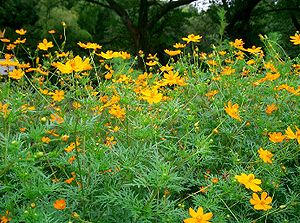
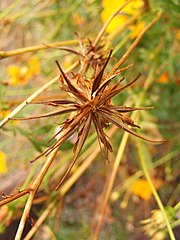
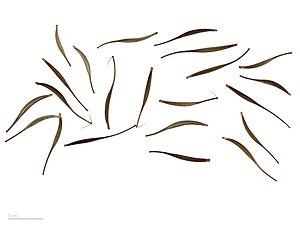 幼苗 花丛 瘦果 瘦果
幼苗 花丛 瘦果 瘦果 花期長,为6月-11月,而一般来说,春播硫華菊花期6-8月,夏播花期9-10月。开直径3-5厘米的黄、金黄和橙色花,而在改良種中有开红色花朵的品種;中心管状花为黄色或褐红色。其花型有单瓣和重瓣两种,园艺市场出售的是基本上是重瓣品种。
硫華菊不易受病虫侵害,但在初夏的新芽附近会有蚜虫生长。硫華菊在贫瘠的土壤中只需适量水就可以正常生长,是生命力顽强的植物,易于养护。此花在阳光不充足的环境下也勉强可栽培,但在这种环境下要注意防止叶片变形。
18世紀末,西班牙马德里植物园首次种植硫華菊,从此硫華菊被该植物园的园长、硫華菊的命名人安东尼奥·何塞·卡瓦尼列斯引入欧洲。据残存的文献记载,硫華菊是於大正時代初期传入日本,现在是日本主要的园艺花卉品种之一。
硫華菊在韩国生长也很普遍,街道旁大量生长这种花。1950年代,农学家、植物学家禹長春博士建议引进此花,之後此花在韩国大量栽培。[3]
1996年,硫華菊被美国东南部外来有害植物理事会(SE-EPPC)宣布为入侵物種。[4]
目前主要的硫華菊栽培种包括:
发芽需要7-21日,最适温度为24°C,发芽50-60日後开花。其耐贫瘠沙质土壤,原本生长在墨西哥的碱性土壤地区,因此适宜土壤pH为6.0-8.5。阳光明媚的天气有利于开花,但也可耐受半阴条件。出芽後的植株耐旱能力强,不易受病虫侵害,这种强大的生活力已在美国的一些虫害区证实。
不同颜色的硫华菊
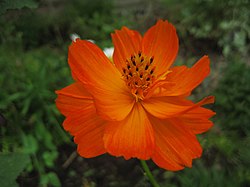
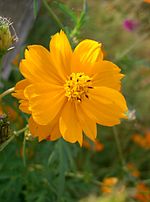
硫華菊的花语是野性美[5]。而這種花在1997年由小田茜主演的日本电影《秋樱》(秋桜,Remembering The Cosmos Flower)中作为主要的意象出现。
硫華菊(学名:Cosmos sulphureus),又名黄秋英、黄波斯菊、黄花波斯菊、硫黄菊、硫磺菊、黄芙蓉,是菊科秋英屬的一年生草本植物,原产於墨西哥,在海拔1600米以下地区自然生长。种加词sulphureus的本意就是“硫磺的”。
此植物喜阳耐半阴,耐寒性一般,是由大波斯菊(Cosmos bipinnatus)与同属其他种自然杂交得到,现在是广泛栽培的园艺花卉和切花材料。硫华菊株形较凌乱,因此适合丛植,无法像大波斯菊一样可用来布置花境。

キバナコスモス(黄花コスモス、学名:Cosmos sulphureus)は、キク科コスモス属の多年草または一年草[1]。コスモスの名を冠するが、オオハルシャギクとは同属別種にあたり互いを交配する事は出来ない。
現在では日本で広く園芸品種のひとつとして栽培されているが、一部は逸出して野生化している。
原産地はメキシコで、標高1600m以下の地域に自生する。18世紀末にスペイン・マドリードの植物園に送られ、ヨーロッパに渡来した。日本には大正時代の初めに輸入された記録が残っている。
高さは約30〜100cm。概ね60cm程度に成長するが、鉢植えやプランター向けの20cm程度に留まる矮性種も出回っている。オオハルシャギクと比べて葉が幅広く、切れ込みが深い。また夏場の暑さに強いため、オオハルシャギクよりも早い時期に花を咲かせる傾向にある。またオオハルシャギクよりも繁殖力が旺盛である為、こぼれ種で栽培していると数年後にはオオハルシャギクを席巻してしまう。
花期は比較的長く、6月から11月にかけて直径3〜5cm程度の黄色、またはオレンジの花を咲かせる。改良種として濃い赤色の品種も作られている。花は一重咲きと八重咲きがあるが、園芸品種として市場に出回っているもののほとんどは八重咲き。
病害虫による大きな被害を受けることは少なく、初夏から夏にかけて新芽の付近にアブラムシがつく程度である。痩せた土壌でも適度の水を与えていれば問題無く成長するため、頑強で育て易い植物といえる。ただし日陰での栽培には向かず、充分な日照が無い環境では葉などの形が崩れる場合があるため注意が必要。
成長に伴って良く分岐する特性があり、咲き終えた花がらの摘み取りや、夏場に一旦切り戻しを行うなどの手入れを施すと長い期間花を楽しむ事が出来る。
前述の通りオオハルシャギクとは交配出来ないが、チョコレートコスモスとは交配可能。このキバナコスモスとチョコレートコスモスの交配種は「ストロベリーチョコレート」と呼ばれる。
キバナコスモス(黄花コスモス、学名:Cosmos sulphureus)は、キク科コスモス属の多年草または一年草。コスモスの名を冠するが、オオハルシャギクとは同属別種にあたり互いを交配する事は出来ない。
現在では日本で広く園芸品種のひとつとして栽培されているが、一部は逸出して野生化している。
노랑코스모스(Cosmos sulphureus)는 국화과의 한해살이풀이다. 멕시코 원산이며, 한국에는 1930~1945년에 들어왔다.[1] 관상용 식물로 심어 기르며, 심어 기르던 것이 야생화되어 절로 자라기도 한다.[2]
키는 40~100센티미터에 이르고 줄기는 곧게 서며 가지를 많이 치고 털이 없다. 잎은 마주나는데 줄기 아래쪽 것은 잎자루가 길고, 잎몸 모양이 삼각상 난형으로 2회 깃꼴로 깊게 갈라진다. 위쪽 잎은 잎자루가 없다. 꽃은 7~9월에 여러 개의 두화가 가지 끝에 1개씩 핀다. 지름은 5~6센티미터쯤 되며 주황색이다. 통상화는 양성(兩性)이며 끝이 5개로 깊게 갈라진다.[1] 설상화는 무성(無性)이며 끝이 불규칙하게 3~5개의 이 모양으로 갈라진다.[2] 열매는 수과로 약간 굽었으며 긴 부리 모양의 돌기가 있고 2개의 가시가 난다.[1]
잎이 코스모스보다 넓고 끝이 뾰족하게 갈라지는 점이 달라 구분한다.[3]